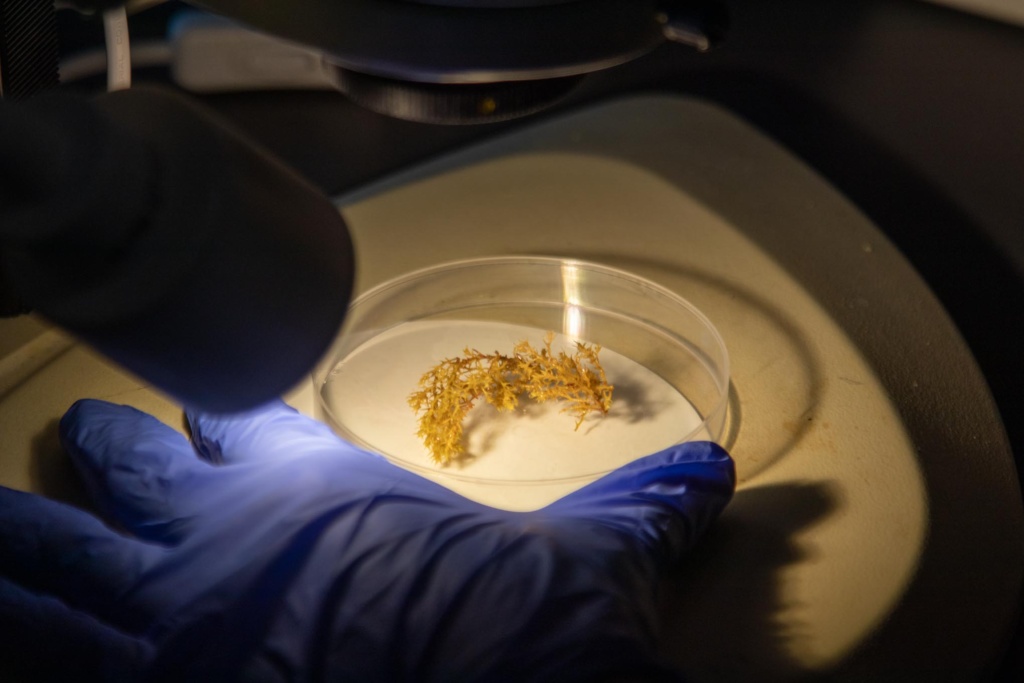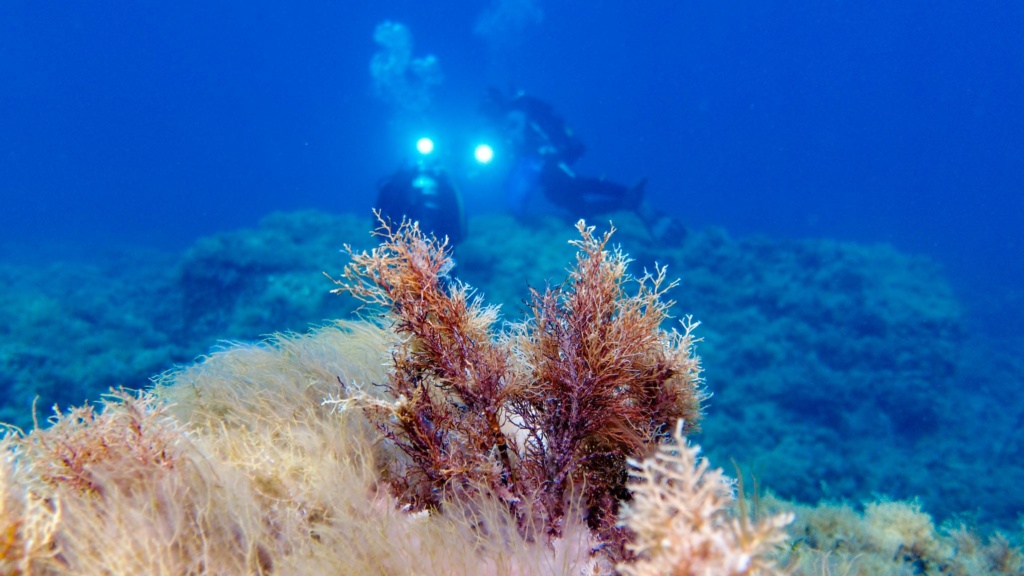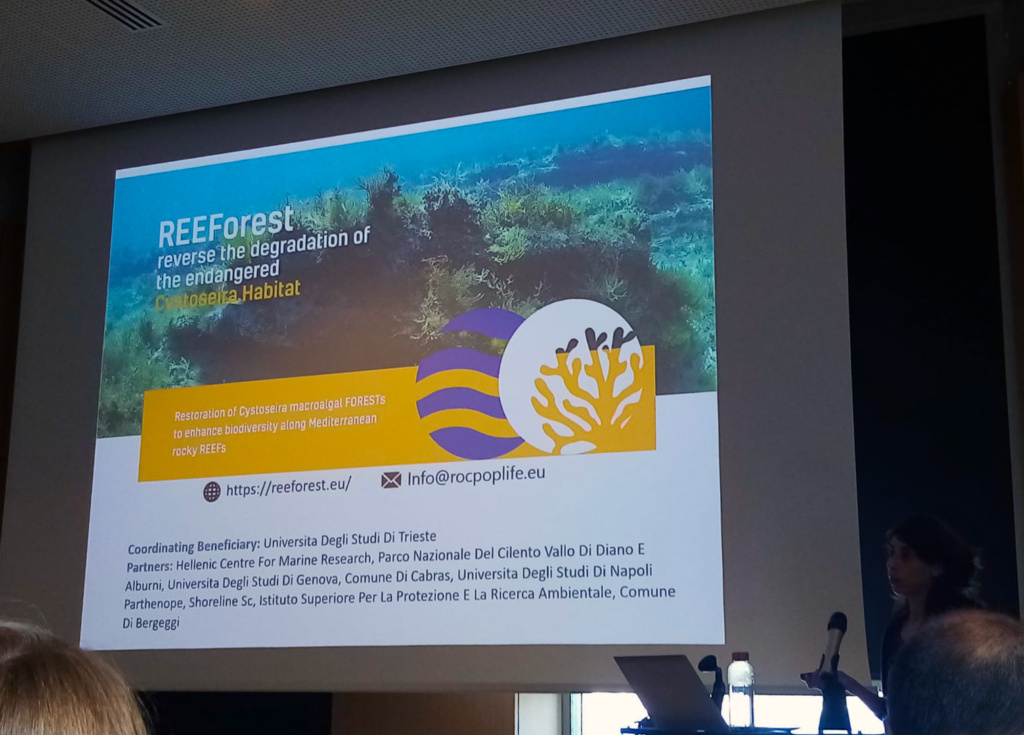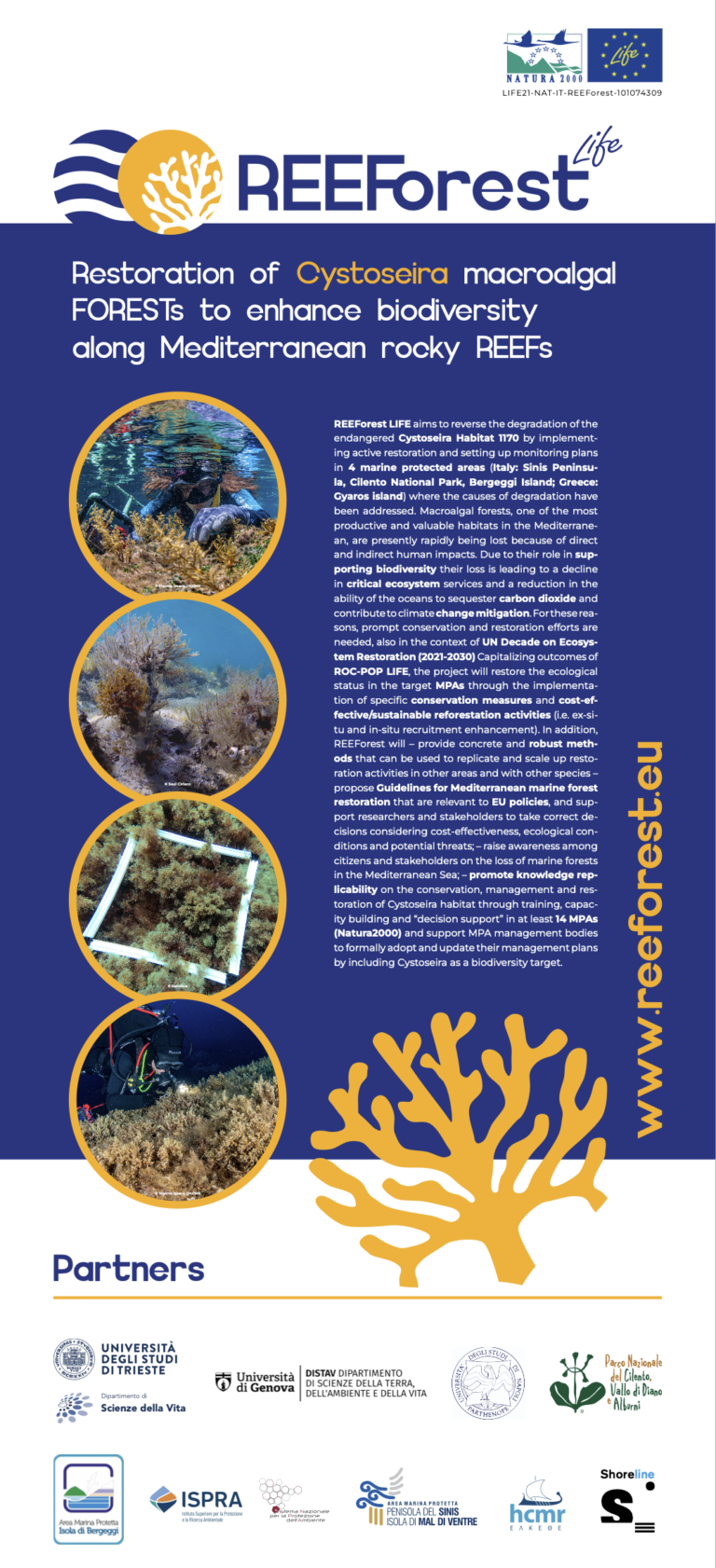Why Cystoseira ?
There is a strong scientific consensus that coastal marine environments, in particular the interface between terrestrial and marine realms, are threatened by human activities, and so are the goods and services they provide. Rebuilding the marine life-support systems that deliver those benefits that society receives from a healthy sea is the key to preserving biodiversity and ecosystem functioning of the Mediterranean Sea.
Cystoseira are a heterogenous group of brown algae, and they are among the most important foundation species in the reef habitat. They are engineers of the sea, able to create complex habitats on rocky seabeds. Real, huge marine forests that give refuge to an innumerable number of other organisms that, without them, would not find a suitable environment to thrive.
The Cystoseira canopy provides several valuable ecosystem services: its presence implies biodiversity enhancement of shallow water benthic ecosystems, provides nursery and foraging areas for several fish and shellfish species, also of commercial interest, and plays a significant role in nutrient cycling and carbon sequestration, helping to tackle the climate crisis. The restoration of Cystoseira habitats is considered a valuable solution to enhance their natural capital stock and increase the capacity of these valuable ecosystem services to be maintained in the long term.
Unfortunately, some Cystoseira species are already regionally extinct, their decline has overall been widely recorded anyway. Sustainable and efficient techniques for the restoration of Cystoseira are needed, and here comes REEForest.
Through the experience of the previous LIFE project “ROCPOP”, we’re going to reverse the negative trend and attempt to restore Mediterranean marine forests to their original extent.
Our job is divided in six working packages that will bring restoration to success.
WP1 - Project Management
The University of Trieste is the leading institution in the management of the REEForest project. As the main intermediary among the collective of partners that compose the project, its role is to coordinate them in each of their unique activities and to stimulate the project advancements to obtain the success of the Cystoseira forests restoration.
The objective of this working package is to ensure that all actions are carried out with quality and on time. This task is achieved through the work of three boards of representatives, composed of delegates from each partner:
The Project Coordination Committee, which oversees any arrangement between the partners, monitors the project achievements and manages the resources available. This team is responsible even for the evaluation of any result or deliverable of the project, to guarantee the highest value and consistency possible.
The Technical Coordination Committee, which is responsible for the functioning of the technical management structure, for example for the update of the performance indicators.
The Administrative Coordination Committee, that take care of all the financial and administrative issues, following the guidelines of the European Community for the sustainability of products and services (Green Public Procurement).
The scientific coordination is carried out by Prof Annalisa Falace from the University of Trieste who, as the project Management Coordinator, is responsible for the realization and execution of the project, to ensure its continuity once is completed, and to act as an intermediary between monitoring authority, the European Climate, Infrastructure and Environment Executive Agency and the partners.
WP2 - Collection and Cultures
The first step to let the Cystoseira forests thrive again in the Mediterranean Sea is to succeed in the cultivation of each species in a laboratory and then implant the new-borns algae in new sites where it’s less or no longer present, therefore leaving the revegetation to happen naturally.
The goal of this work package, the first step in the REEForest restoration effort, is to find a suitable location to collect the fertile parts of the algal bodies to transfer them to a controlled environment where they can be grown and cultured until the juveniles reach the”refuge size”. Once the thalli (the bodies) of the algae are large enough, they will be planted at suitable receiving sites selected in this chapter of the project for their particular habitat characteristics.
The University of Trieste is the leading institution in the coordination of this part of the project, also thanks to the knowledge acquired in the ROCPOP LIFE project, which has proved useful for this task: the underwater sampling is done without affecting the donor population, and even the transport of the fertile apices has a survival rate of 99%.
The donor sites are inside four Marine Protected Areas that are also partners in the project:
- Penisola del Sinis – Isola di Mal di Ventre – Sardinia, Italy
- Parco Nazionale del Cilento Vallo di Diano e Alburni (Santa Maria di Castellabate and Costa Infreschi e della Masseta) – Campania, Italy
- Isola di Bergeggi – Liguria, Italy
- Gyaros Island – Central Aegean Sea, Greece
The collection of the receptacle apices that contain the “seeds” (i.e. fertile apices with mature receptacles), is repeated three times for each site, once a year for three years, for an estimated total number of 15400 samples. Once transported in one of the three nearest cultivation facilities (located at the University of Trieste, at the University of Genova, and at the Hellenic Centre for Marine Research), they are placed on clay discs with a diameter of four cm, called “Reproductive Units”.
The fertilization of the eggs, which happens inside the reproductive structures, occurs without artificial intervention. The number of new embryos growing in this way is estimated at 1275000. The researchers will then take care of them until they reach the juvenile stage, ready for the next step of the REEForest project.
WP3 - Active Restoration
The main chapter of the REEForest project, the actual planting of the laboratory-grown algae on the rocky reefs, begins with the transport of the juvenile thalli from the controlled environment to the receiving sites; this technique is called ex-situ outplanting. To achieve optimal restoration of the algae population, an additional method is also used, directly with the algae still found in the donor site, called in situ outplanting.
The ex-situ technique is going to be applied to all the Marine Protected Areas that are part of the project. In addition, only Cilento and Sinis ones will be involved in the in-situ method, to induce even more production of new algal individuals.
The University of Trieste is the lead institution for this work package and, together with the Universities of Genoa and Parthenope and the Hellenic Centre for Marine Research, is responsible for transferring the juvenile algae from the cultivation facilities of each institution to the plantations in the nearest field.
To reduce the risk of damage to the algal germlings during transfer, the reproductive units, i.e., the clay disks to which the juveniles have previously attached, are transported in tanks containing the right amount of water, maintained at the right temperature, and housed in special stable structures. Time is also an essential variable for a successful transfer because no matter how far the laboratory is from the protected area where the algae are grown, the transfer takes no more than eighteen hours in any case.
Different Cystoseira species are planted by the ex-situ method in different coastal areas: clay tiles with Cystoseira amentacea are attached directly to the surface of rocks with screws; this species thrives even when not constantly submerged by water.
The other two target species, Cystoseira spinosa and Cystoseira crinitophylla belong to the infralittoral zone and are planted at the same depth where they thrive in the donor site.
The clay disks on which the latter two species grow are first temporarily fixed on a rustproof iron rod, which is then fixed on the rocks or a concrete slab. The reason for using this type of rigid structure, called an “Outplanting Unit” is simple: it is easier and faster to fix a single support with many reproductive units, requiring fewer bolts, less effort, and avoiding stress to the juvenile algae. As successfully applied in the ROC-POP LIFE project, the work continues at the latest after one year with the last transfer of each plate on which the adult algae have survived on the rocks.
The in-situ method consists of placing biodegradable mesh bags with fertile Cystoseira branches, with fertilization and seed growth occurring without intervention. Seeds are released through the mesh of the net bags and settle on the rocky substrate around them. Although embryo survival and growth are naturally less efficient than in mesocosms (laboratory) due to higher natural mortality, the advantage of this technique is that it requires less human intervention, is less costly, and allows for more sequential interventions.
Both techniques together will lead to an increase in the total number of thalli in the period after the end of the project due to the natural spillover effect already one year after transplantation.
WP4 - Monitoring and Evaluation
Throughout all the REEForest actions, a series of monitoring activities are performed to assess if the project is proceeding in the right direction or if some change should be done to reach at best our objectives. The institution that coordinates this section of the project is the University of Genova.
First, every partner involved in the cultivation of Cystoseira must check if the fertile parts taken from the algae body (called “thallus”) underwater were collected and transported to the laboratory properly: the aim is to receive, in the respective cultivation facilities, the right amount of apices bringing enough mature receptacles releasing seeds only after being placed on the clay discs.
After the arrival in the cultivation facility, is essential to check whether the growth of the embryos in the laboratory proceeds as planned and of course, once moved back into the sea, if the planting process in the respective sites has been effective.
Then, if everything went as planned, the new, expanded Cystoseira population brings an improvement of the ecological status inside and around the planting site, with a resulting measurable impact even at socio-economic level on the nearby community.
The data collected during cultivation and subsequent planting in the four Marine Protected areas, which are also Natura 2000 sites, allow the performance of the restoration to be evaluated. Regarding the efficiency of cultivation, the percentage of juveniles surviving on the tiles after being transported to the field will be, among others, the final performance indicator outlining the success of this complex process.
To measure the outplanting efficacy, both for in-situ and ex-situ techniques, high-resolution images and videos will be acquired and will be used for monitoring the growth and health status of implanted juveniles, acquiring the condition of the welfare of both the planted and their “natural born” new offspring that could be compared to the survival and growth rate, fertility, and distribution before the restoration actions.
In particular, the habitat improvement after the project activities are completed is assessed with the perspective of meeting the objectives set by the Water Framework Directive and Marine Strategy Framework Directive of the European Union. Other positive effects of the return of Cystoseira on the seafloor are evaluated using all the descriptors present in the Good Environmental Status directive, including “CARLIT” (Cartography of littoral and upper-sublittoral rocky-shore communities), “EEI” (Ecological Evaluation Index) and “reef-EBQI” (Ecosystem-Based Quality Index) indices. In this way, we can measure the improved ecological status of the coast where Cystoseira is being planted as well as verify if the restoration of marine forests produced a recovery at an ecosystem level.
This project’s action concludes with the production of a replicable methodological protocol for coastal monitoring and mapping of Cystoseira habitats, using an innovating combination of geographic information systems (GIS) and the acquisition of 3D photogrammetric data using remotely piloted aerial systems (drones), all carried out by ISPRA (Istituto Superiore per la Protezione e la Ricerca Ambientale).
At the end of the project, we expect for ex-situ outplanting, the survival of at least 2/3 of the transplanted tiles with at 1 adult individual each (i.e., 2400 plants for Sinis and CilentoNP and 1000 plants in the other target sites) and for in-situ restoration the survival and growth of 1000 plants in each target site.
WP5 - Dissemination and Communication
Communication of REEForest activities and objectives is crucial for taking Cystoseira conservation efforts beyond the active restoration carried on by the other working packages. Through a variety of communication initiatives, the involvement of both the general and specialized public brings the impact of the project towards broader effectiveness in terms of understanding the importance of marine forests and how to protect them, those people and communities that can make a difference.
Raising awareness, disseminating information, and spreading knowledge of how REEForest achieved the restoration of Cystoseira and thus the improvement of the status of one of the most important marine ecosystems, is part of this chapter of the project, led by Shoreline.
The main objectives are here to widen and strengthen the existing stakeholder network inherited from the ROCPOP LIFE project, influence the public perception through outreach initiatives, and therefore influence behaviors that could impact positively on marine biodiversity. Ringing our reliable restoration protocol to the attention of the scientific community, involving economic actors, and finally promoting the European LIFE programme and the N2000 network as tools for implementing biodiversity policy in the community will also bring beneficial changes to communities living near Cystoseira habitats.
The communication chapter of REEForest specially binds together the previous working package, aimed at evaluating and, if necessary, applying corrections to project actions, with the following one, that takes care of maintaining the project’s results and exploits their combined effects. It is not only a matter of enabling other organizations to replicate the project appropriately, but of bringing the Sea Forests restoration to become a landmark for the coastal ecosystem management and ultimately of taking the REEForest approach to governance and institutional level, both nationally and internationally.
The presence of prestigious research Institutes (University of Trieste, University of Genova, University of Napoli-Partenophe, Hellenic Centre for Marine Research, Institute for Environmental Protection and Research) in partnership with many Marine Protected Areas (Gyaros Island, Isola di Bergeggi, Parco Nazionale del Cilento, Penisola del Sinis) will allow supporting the project at scientific level. It also enables the establishment of a series of virtuous relationships with policymakers able to help the fulfillment of the Marine Strategy Directive, the Recovery and Resilience Plan (PNRR), but also the European Green Deal.
This conceptual model refers to the purpose of integrating, where possible, every aspect of the project into an institutional and legislative agenda. In this way, we could manage to let the Cystoseira marine forests be added to the IUCN list of threatened habitats, including habitat 1170 (underwater reefs) in the national environmental accounting framework. Moreover, our approach helps to provide an operational tool for managers to update their management plan using the Standardised Interventions of Effective Management of Marine Protected Areas (ISEA), particularly in Specially Protected Areas of Mediterranean Interest (SPAMI).
Spreading the important role of these environments in a restoration perspective, combined with the biophysical and monetary valuation of the natural capital of Cystoseira habitat enhances the chance to form a core of “influencers” in the national and international conservation network. The actors that already expressed their interest in participating in the communication events of REEForest are Regional Activity Centre for Specially Protected Areas (SPA/RAC), Mediterranean Protected Areas Network (MedPAN), Adriatic Protected Areas Network (AdriaPAN), WWF Mediterranean Programme Office (WWF MedPO), Marevivo, WWF Greece, Hellenic Society for the Study & Protection of the Monk Seal (MoM), Hellenic Society for the Protection of Nature (HSPN), Pelagos Cetacean Research Institute and many others.
With their help, the project’s capabilities to proceed alongside the 2030 Agenda for Sustainable Development and United Nation’s Decade on Ecosystem Restoration (2021-2030) are higher than ever, allowing REEForest to achieve its long-term goals even after the official end of the project.
WP6 - Sustainability, replication and exploitation of project results
The last working package, led by the University degli Studi Di Napoli – Parthenope, aims to amplify the impact of REEForest by transferring the project’s good practices, know-how, and methodologies to other Marine Protected Areas or research institutions. This objective involves, like the communication part, all the other chapters of the project, so that any actor interested in replicating the restoration activities can repeat or even improve on our work once it is completed.
Concerning the conservation, economic evaluation, monitoring, and the core part of the project, the actual restoration, we develop guidelines, toolkits, methodological protocols, manuals, lessons, and media that could spread the REEForest message and help to replicate the project in many other places in the Mediterranean Sea.
Eleven Mediterranean Marine Protected Areas have already been reached by the Cystoseira habitat awareness campaign launched under the previous ROC-POP LIFE project. We plan to involve more institutions that are willing to express their interest in training, replication, and transferability of REEForest, and want to implement their management plans.
In Greece, the Natural Environment and Climate Change Agency (NECCA), the competent national Nature 2000 network authority which coordinates the implementation of the policy for all national protected areas, already supports the dissemination of REEForest results in its network and will enact the achievements, results, and accomplishments of LIFE REEForest at the national level.
In Italy the Ministry of Environment and Energy Security (MASE) developed a unified strategy called “Skills and Networks for Environmental Integration and Improvement of Public Administration Organisations” (CReIAMO PA) to prepare actions to overcome critical issues in the governance of environmental policies. In this framework ROCPOP life has already been invited to describe and propose new actions to be promoted under the new National Marine Strategy Programme of Measures, therefore REEForest is going to fit in continuity with our past success to stimulate replication of the actual project.
As REEForest proceeds, a Replication Plan is gradually being drafted until it contains all the information needed to ensure the knowledge transfer to stakeholders and other institutions. It will contain a protocol for replication, the campaign to gather additional restoration sites, the development of teaching and replication tools, and much more. All project partners will be involved in the development of the plan according to a collaborative and interdisciplinary approach. Its content will be incorporated into the After LIFE Plan, which is designed to assuring that REEFforest continues beyond the project’s lifetime.
The replications tools are being developed to improve skills related to monitoring activities, the preparation of management plans, and Cystoseira habitat restoration strategies, as the plan, is being drafted throughout the REEForest activities. The beneficiaries of these tools are Marine Protected Area managers, public administrators, researchers or environmental management professionals, and university students.
With all these initiatives we are sure to be able to transfer laboratory, transport, deployment, and communication techniques protocols, that could be potentially applied to species other than Cystoseira ones, to all the actors involved in topics inherent restoration of Sea Forests.














